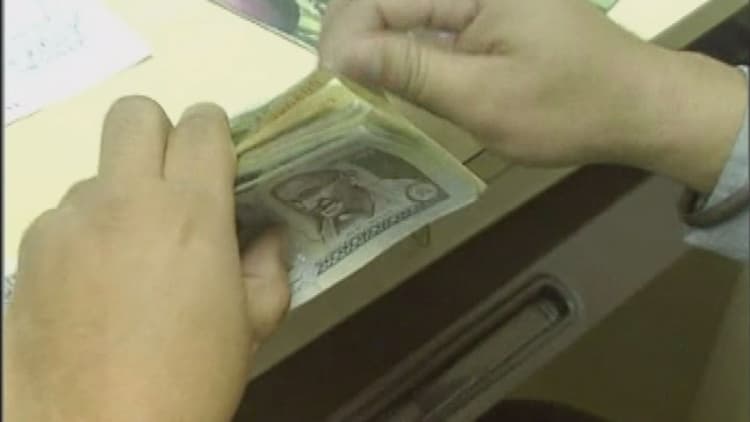
Long queues outside bank branches and ATMs, frowning faces of small business owners and stranded tourists have become commonplace as a cash crunch grips India.
But analysts argue the unseen impact of the government's decision to wipe out 86 percent of the total value of currency in circulation to fight corruption and counterfeiting goes deeper and could see short-term pain for India's economic trajectory but eventual long-term gains.
On Nov. 8, Prime Minister Narendra Modi announced 500 and 1,000 rupee banknotes would be withdrawn from circulation, replaced by new 500 and 2,000 denomination notes, in a surprise demonetization move that caught most people off-guard.
Near-term blow
The government's demonetization effort has already disrupted the cash-intensive areas of the economy, including everyday shopping for food and supplies.
HSBC's chief India economist, Pranjul Bhandari, said in a note that about 60 percent to 80 percent of India's consumption basket is cash-intensive, including food, transport, real estate and restaurants. "We assume that growth for these components halve on the back of the monetary shock," Bhandari wrote. She expected India's full fiscal year gross domestic product (GDP) growth to be 0.7 to 1 percentage point lower.
A chief target of Modi's demonetization efforts is India's burgeoning shadow economy, which Bank of America Merrill Lynch (BAML) research analyst Sanjay Mookim estimates at 25 percent to 30 percent of GDP. In a note, Mookim said the immediate impact on the black economy could lead to a "much slower consumption," especially once a new India goods and services tax (GST) kicks in next year.
Analysts pointed out there could still be some beneficial outcomes - first, it would cut the supply of black money circulating the economy and bring some of it into the formal economy over time. Secondly, the government could see tax gains if it succeeds in "unearthing unaccountable money" from the shadow economy, according to analysts from Singapore's DBS Bank.
Impact on daily life
There is a growing divergence between India's official and effective money supply. The latter referred to the amount that was available for carrying out daily financial transactions and affects the overall demand for goods and services.
Currently, the limit for over-the-counter exchange of old currency notes for new ones is at 2,000 rupees. Old currency above the withdrawal amount can still be deposited in banks until Dec. 30. However, Indian media reported that ATMs in the country were running out of new notes to dispense, while many bank branches were facing cash shortages due to lack of cash transporting vehicles, according to the Times of India.
Sectors that relied heavily on cash transactions, including real estate, construction, gold, gems and jewelry as well as the informal sectors are expected to suffer a near-term decline in consumption demand.
"Small and marginal farmers in the fruits and vegetable category typically require off-loading of their produce in the local mandi (wholesale market) in cash and could see an immediate impact," according to analysts from India Ratings and Research (Ind-Ra).
The services sector, which BAML's Mookim pegs at 61 percent of India's GDP, could also take a hit. "The current disruption is not a postponement of income, but is lost revenue," he explained, adding the impact on consumption will outlast the physical cash shortages.
Given India's companies have been more conservative with their investment plans given the slowdown in the economy as well as their bad debt problems, a drop in consumption would push growth lower unless compensated by gains in fiscal spending and trade gains.
Credit impact
Ind-Ra analysts estimated the impact of the cash crunch will be felt through the real estate and construction sectors, which are strongly related to other sectors such as cement, steel and they will "turn credit negative in the short-run."
As a result, it could affect daily and weekly wage employment in the construction sector, which the analysts added had one of the highest employment multipliers.
On the flip side, the policy has at least a short-term positive impact on India's banking sector because withdrawal limits allow the deposit base to grow quickly as cash is deposited. In the longer term, improved liquidity could support lower deposit and lending rates.
In an interview with the Economic Times last week, State Bank of India's chairman Arundhati Bhattacharya said interest rates will fall very soon, but declined to specify any timeline.
HSBC's Bhandari estimated that if the government could encourage more widespread adoption of cashless payments in the medium term, it could permanently improve liquidity in the banking system.
Lower inflation, rate cuts?
The temporary shortage in cash and related fall in buying may also lead to lower consumer food prices as crops benefited this year from ample annual monsoon rains crucial for farmers.
DBS Bank expects the consumer price index (CPI) to average about 20 basis points below their 4.8 percent annual estimate, which the bank said would offset a more than 14 percent hike in public sector wages announced earlier this year.
This could leave the door open for the Reserve Bank of India to cut its repo rate by 25 basis points in the first quarter of 2017 and "odds for another 25-basis-point cut within first half 2017 will gain traction."


